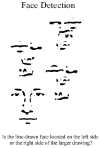A female advantage in basic face recognition is absent in schizophrenia
- PMID: 20346519
- PMCID: PMC2860063
- DOI: 10.1016/j.psychres.2009.02.005
A female advantage in basic face recognition is absent in schizophrenia
Abstract
Healthy females outperform males on face recognition tasks. Relative to healthy individuals, schizophrenia patients are impaired at face perception. Yet, it is unclear whether the female advantage found in healthy controls is preserved in females with schizophrenia. In the present study, we compared male and female patients and healthy controls on two basic face perception tasks - detection and identity discrimination. In the detection task, subjects located an upright or inverted line-drawn face (or tree) embedded within a larger line-drawing. In the identity discrimination task, subjects determined which of two side-by-side face images matched an earlier presented face image. Healthy females were significantly more accurate than healthy males on face detection, but not on identity discrimination. However, female patients were not more accurate than male patients on either task. On both upright face detection and face identity discrimination, healthy controls significantly outperformed patients. Patients' performance on face detection was closely associated with tree detection and IQ scores, as well as level of psychosis. This pattern of results suggests that a female advantage in basic face perception is no longer available in schizophrenia, and that this absence may be related to a generalized deficit factor which acts to level performance across sexes, and putative changes in sex-related neurobiological differences associated with schizophrenia.
Copyright 2009 Elsevier Ltd. All rights reserved.
Figures




Similar articles
-
Face and body perception in schizophrenia: a configural processing deficit?Psychiatry Res. 2012 Jan 30;195(1-2):9-17. doi: 10.1016/j.psychres.2011.07.017. Epub 2011 Jul 30. Psychiatry Res. 2012. PMID: 21803427
-
Visual and cognitive processing of face information in schizophrenia: detection, discrimination and working memory.Schizophr Res. 2009 Jan;107(1):92-8. doi: 10.1016/j.schres.2008.09.010. Epub 2008 Oct 23. Schizophr Res. 2009. PMID: 18947982 Free PMC article.
-
Females excel at basic face perception.Acta Psychol (Amst). 2009 Feb;130(2):168-73. doi: 10.1016/j.actpsy.2008.12.005. Epub 2009 Jan 20. Acta Psychol (Amst). 2009. PMID: 19159861
-
Psychophysical study of face identity discrimination in schizophrenia: association with facial morphology.Cogn Neuropsychiatry. 2016 Nov;21(6):525-538. doi: 10.1080/13546805.2016.1240073. Epub 2016 Oct 13. Cogn Neuropsychiatry. 2016. PMID: 27736366
-
Facial emotion perception in Chinese patients with schizophrenia and non-psychotic first-degree relatives.Prog Neuropsychopharmacol Biol Psychiatry. 2010 Mar 17;34(2):393-400. doi: 10.1016/j.pnpbp.2010.01.007. Epub 2010 Jan 15. Prog Neuropsychopharmacol Biol Psychiatry. 2010. PMID: 20079792
Cited by
-
Facial emotion perception abilities are related to grey matter volume in the culmen of cerebellum anterior lobe in drug-naïve patients with first-episode schizophrenia.Brain Imaging Behav. 2022 Oct;16(5):2072-2085. doi: 10.1007/s11682-022-00677-y. Epub 2022 Jun 25. Brain Imaging Behav. 2022. PMID: 35751735
References
-
- Bruce V, Young A. Understanding face recognition. British Journal of Psychology. 1986;77:305–327. - PubMed
-
- Calder AJ, Young AW. Understanding the recognition of facial identity and facial expression. Nature Reviews: Neuroscience. 2005;6:641–651. - PubMed
-
- Chapman L, Chapman J. Disordered Thought in Schizophrenia. Apple Century Crofts; New York: 1973.
Publication types
MeSH terms
Grants and funding
LinkOut - more resources
Full Text Sources
Medical

